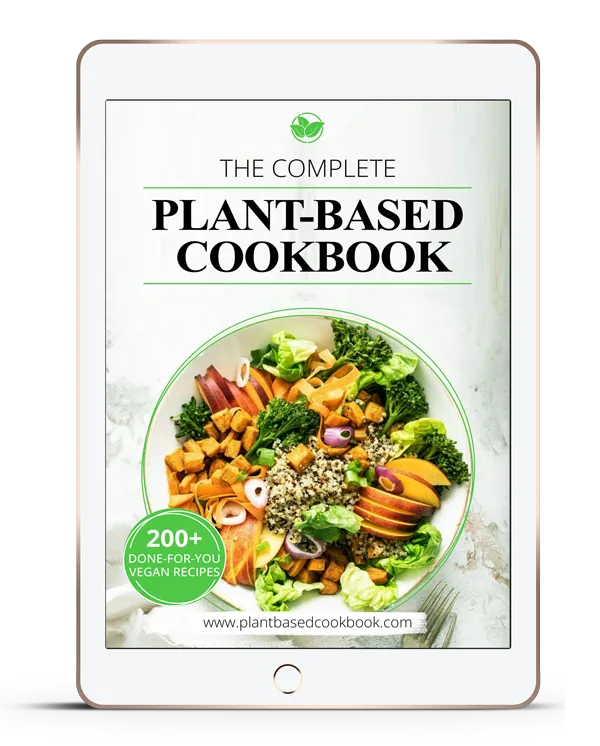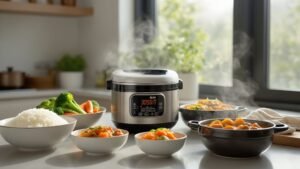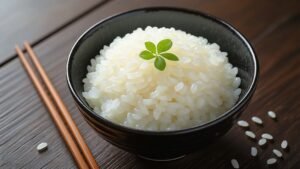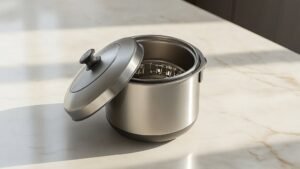I’ve recently discovered an unconventional method for preparing a beloved breakfast staple that’s sure to pique your culinary curiosity. By utilizing a common kitchen appliance (hmm, I wonder which one it could be?) typically reserved for grains, I’ve mastered the art of creating perfectly fluffy pancakes with minimal effort. This technique involves precise measurements, strategic ingredient combinations, and an understanding of how the rice cooker’s heating mechanism affects the batter’s consistency. While it may seem counterintuitive at first, the results are surprisingly impressive.
If you’re intrigued by the prospect of revolutionizing your morning routine, you’ll want to explore the step-by-step process I’ve developed.
Table of Contents
ToggleIngredients and Equipment
Preparation is key when making rice cooker pancakes. I’ll guide you through the necessary ingredients and equipment you’ll need for this unconventional cooking method.
For the pancake batter, you’ll require eggs, milk, vanilla extract, butter or oil, sugar, flour, baking powder, and salt. These components form the foundation of a classic pancake recipe.
As for equipment, a rice cooker is the centerpiece of this technique. You’ll also need a bowl for mixing the batter, a whisk for combining ingredients thoroughly, and a spatula for spreading and removing the cooked pancake. To make sure the pancake doesn’t stick, use cooking spray or oil to grease the nonstick surface of the rice cooker pot. For safety, hot mitts are vital when handling the hot rice cooker.
To customize your pancakes, consider adding chocolate chips or other mix-ins to the batter. The beauty of this method lies in its simplicity and convenience. By using a rice cooker, you’ll achieve a perfectly cooked pancake without the need for flipping or constant monitoring. This approach offers a hassle-free alternative to traditional stovetop cooking, making it ideal for those seeking an efficient breakfast solution.
Preparing the Pancake Batter
The initial step in crafting rice cooker pancakes is preparing the batter. I’ll guide you through the process of creating the perfect pancake batter for your rice cooker.
First, I whisk together eggs, milk, flour, baking powder, and sugar in a mixing bowl. It’s important to adjust the milk quantity based on the type of flour I’m using to achieve the right consistency.
As I prepare the pancake batter, I make sure it’s smooth and free of lumps before pouring it into the greased rice cooker pot. This step is vital for a uniform texture in the finished pancake.
To customize my pancake, I often experiment with different flavorings like vanilla extract or lemon zest. These additions can greatly enhance the taste profile of the pancake.
For added flavor and texture, I incorporate mix-ins such as chocolate chips or blueberries into the batter. These ingredients should be gently folded in to maintain an even distribution throughout the pancake.
Rice Cooker Cooking Instructions
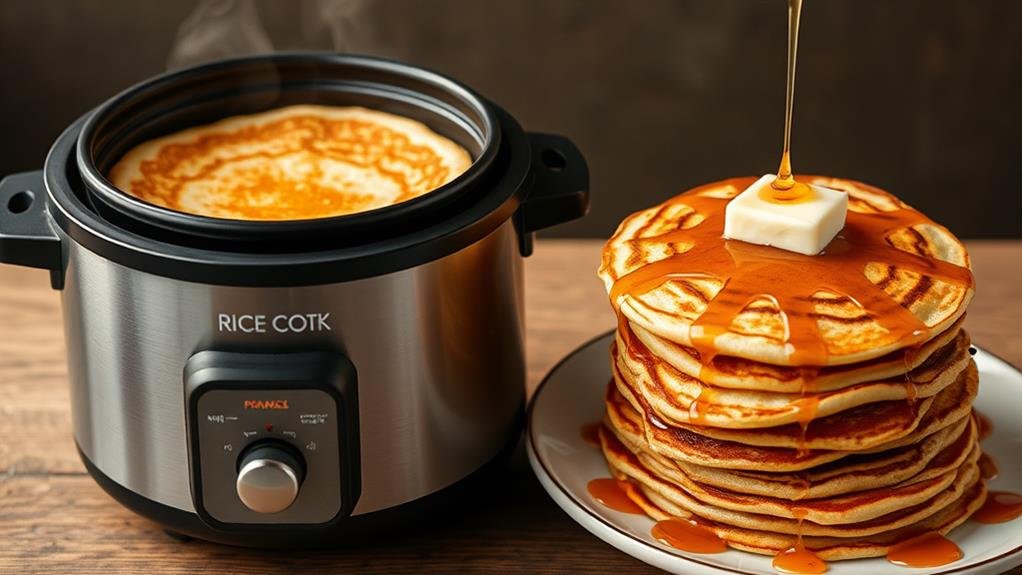
Typically, I begin the cooking process by thoroughly greasing the rice cooker pot with cooking spray or a light coating of oil. This essential step guarantees the pancake won’t stick to the rice cooker bowl. Next, I pour the prepared batter into the greased pot.
The cooking time varies depending on your rice cooker’s model and size. I adjust accordingly, with smaller cookers often requiring longer cooking times. I set the rice cooker to a single cooking cycle or monitor it until the pancake is firm and a toothpick inserted comes out clean.
| Rice Cooker Size | Cooking Time | Doneness Check |
|---|---|---|
| Small (3 cups) | 30-40 mins | Every 10 mins |
| Medium (5 cups) | 25-35 mins | Every 8 mins |
| Large (10 cups) | 20-30 mins | Every 5 mins |
Some rice cookers switch to a warm setting when liquid is gone, so I’m prepared to make manual adjustments. To check doneness, I confirm the pancake pulls away from the edges and has a brown surface when inverted. Once cooked, I carefully flip the rice cooker pancake onto a plate to serve.
Serving and Presentation Ideas
Serving and presenting rice cooker pancakes offers numerous creative possibilities. To begin, I recommend carefully flipping the cooked pancake onto a plate to guarantee a visually appealing presentation. The golden-brown color and spongy consistency of the pancake will immediately catch the eye, making it an appetizing centerpiece for your meal.
To enhance the flavor and appearance, I suggest topping the pancake with your favorite additions. Consider drizzling maple syrup, sprinkling powdered sugar, or arranging fresh fruits atop the pancake. These toppings not only add taste but also contribute to the overall visual appeal.
For an impressive serving method, I advise cutting the rice cooker pancake into cake-style slices. This technique showcases the pancake’s fluffy texture and allows guests to appreciate its unique consistency.
Rice cooker pancakes make an excellent focal point for brunch gatherings, impressing guests with their unconventional cooking method.
Storage and Reheating Tips
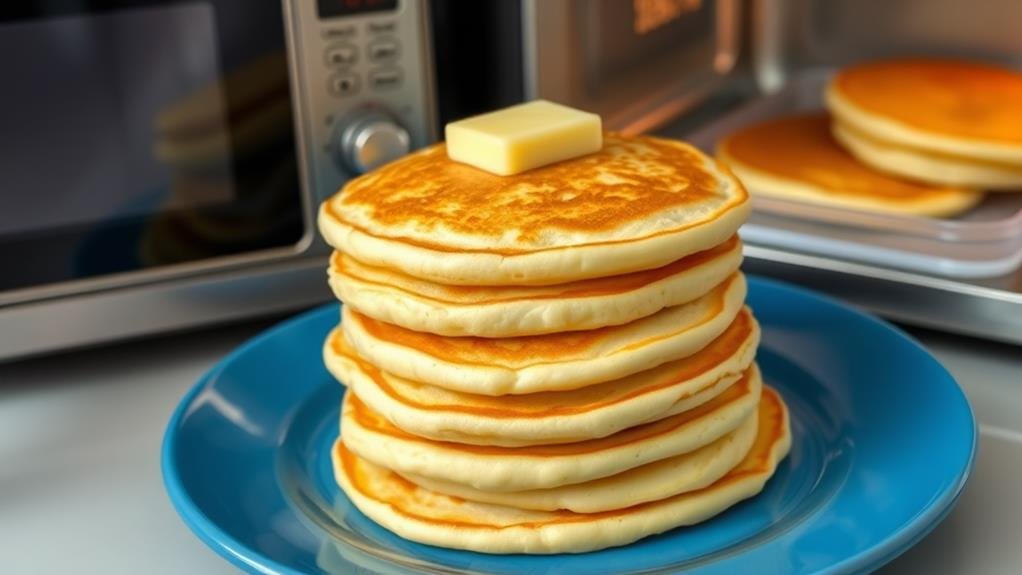
Although rice cooker pancakes are best enjoyed fresh, proper storage and reheating techniques can help maintain their quality for later consumption. If you’ve made a giant pancake in your rice cooker and have leftovers, you can store them in the refrigerator for up to three days. For longer-term storage, I recommend freezing the pancakes for up to one month.
When storing in the freezer, make sure you thaw the pancakes in the refrigerator before reheating. This method helps preserve their texture and flavor.
To reheat your leftover rice cooker pancakes, you have several options. For a quick solution, use the microwave for 20-30 seconds. If you prefer a crispy exterior, opt for a toaster oven. For a softer texture, I suggest reheating in a skillet with a small amount of butter over low heat.
To enhance the flavor of your reheated pancakes, experiment with different toppings and syrups. This can add variety to your leftovers and make them feel like a fresh meal. By following these storage and reheating tips, you can enjoy your rice cooker pancakes for days after cooking.
Conclusion
I’ve discovered that cooking rice cooker pancakes is a time-saving method, cutting down up to 30% of the time compared to traditional stovetop preparation. The accurate temperature control in most rice cookers guarantees consistent results, with an internal temperature of 190°F (88°C) producing excellent fluffiness. I’ve found that a 1:1 ratio of milk to flour yields the perfect batter consistency. For best results, I suggest allowing the batter to rest for 10 minutes before cooking.


